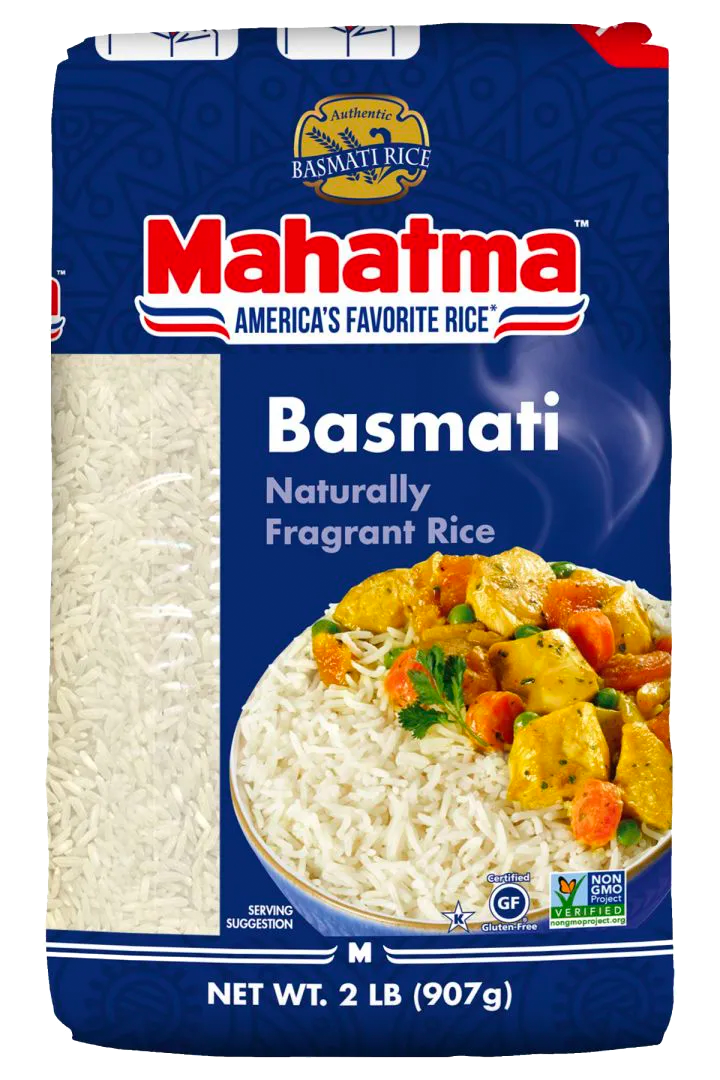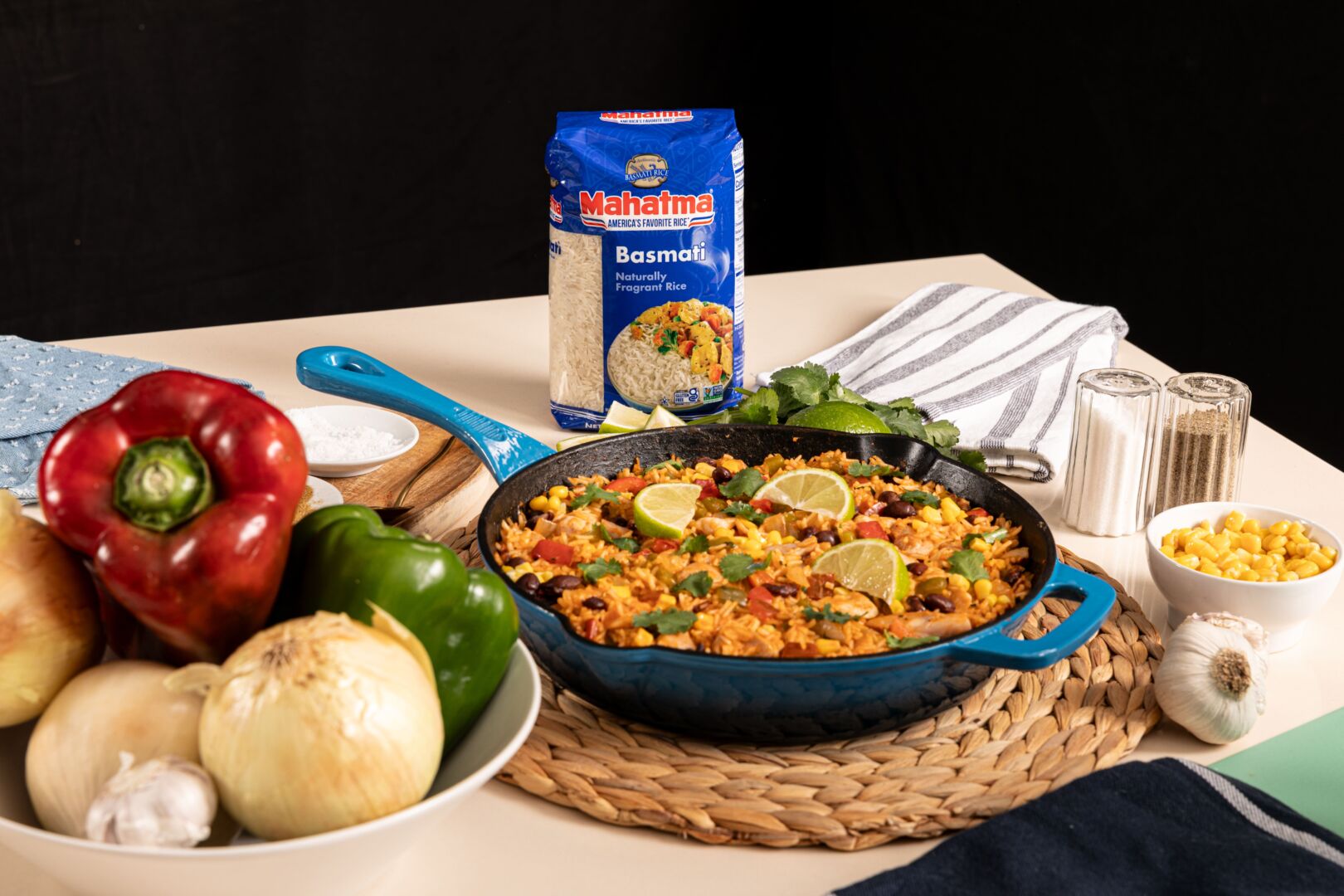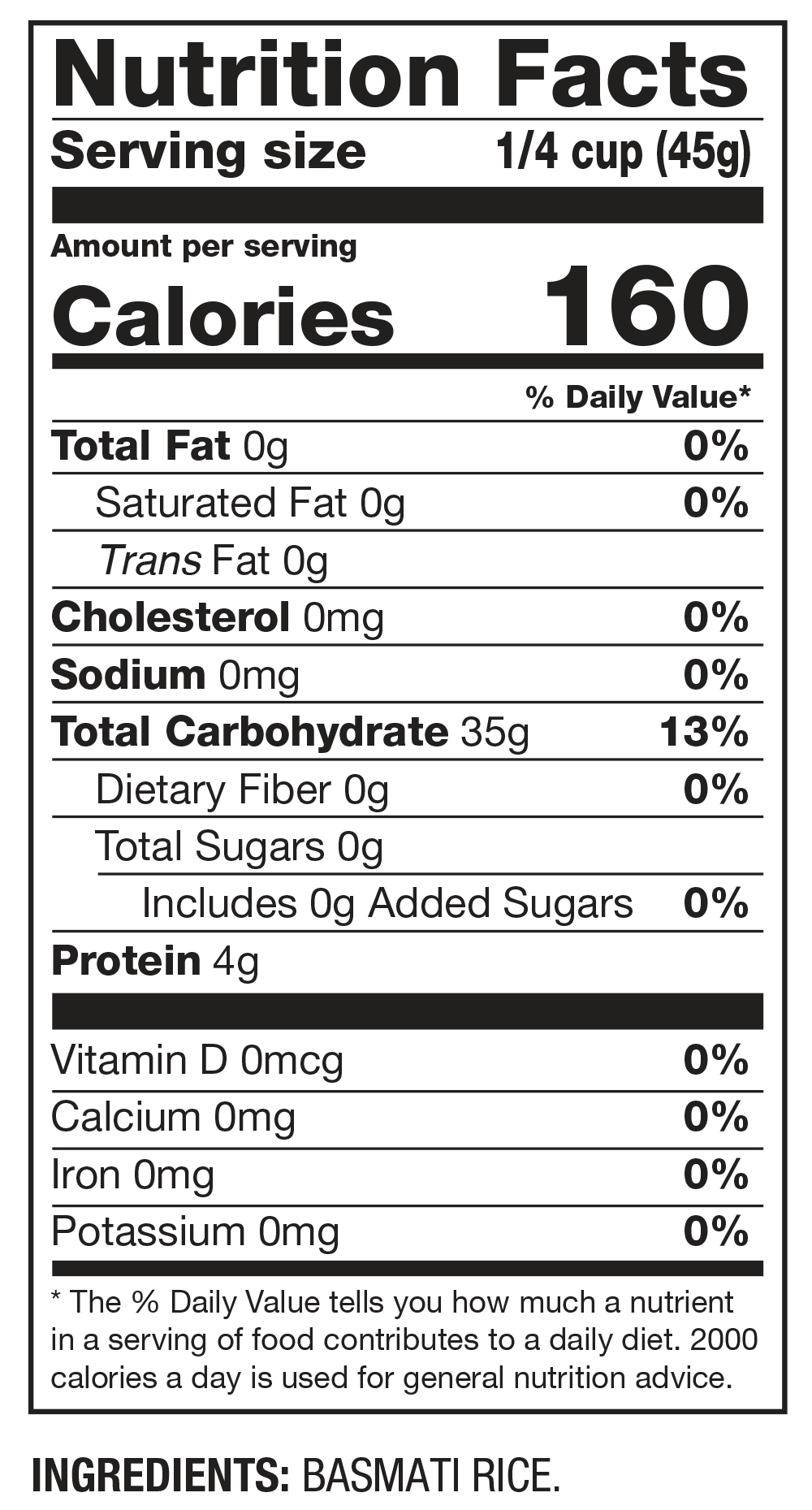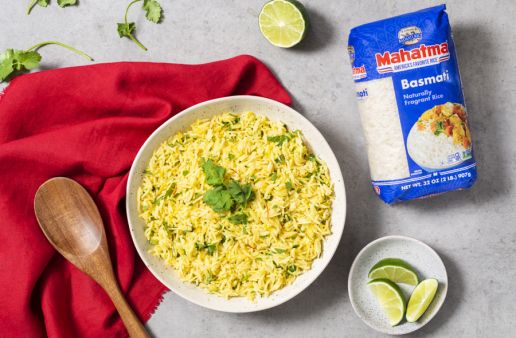- Gluten Free
- Kosher
- MSG Free
- No Preservatives
- Non-GMO Project Verified
- Vegan
- Vegetarian
Basmati Rice
Mahatma® Basmati Rice, imported from India, is an aromatic long grain rice that is grown in the Himalayan foothills.

Basmati Rice
Mahatma® Basmati Rice, imported from India, is an aromatic long grain rice that is grown in the Himalayan foothills.
20 minutes
Available Sizes:
Get all the delicious details
The Origins of Basmati Rice
Basmati is a long-grain rice that has a rich history and a wide range of varieties to explore. Its origins lie in the Himalayan mountains of modern-day Pakistan and north-east India, while its name comes from the Sanskrit language and means “possessing fragrance”.
Flavor and texture of Basmati Rice
Basmati rice is famous for its nutty, floral aroma, imbuing rice dishes with fragrance and flavor. In terms of texture, when boiled it has a light, fluffy quality. On the other hand, when basmati is fried or oven-cooked, it takes on an element of crispiness.
Frequently Asked Questions about Basmati Rice
Just like most varieties of rice, cooking basmati is not complicated as long as you stick to a few simple rules.
Rinsing Basmati Rice
One question people often ask when it comes to cooking basmati rice is whether or not rinsing the rice is necessary. While some recipes recommend rinsing the rice to remove the excess starch, it is not always essential. Rinsing can help achieve fluffier rice by removing the surface starch, but it can also cause the rice to lose some of its natural flavor. If you prefer fluffier rice, it is recommended to rinse the basmati rice under cold running water until the water runs clear. Alternatively, if you prefer stickier rice with more flavor, you can skip the rinsing process.
Cooking Methods for Basmati Rice
There are various cooking methods for preparing basmati rice, each with its own considerations. The stovetop method is the most traditional and widely used. To cook basmati rice on the stovetop, simply combine the rinsed rice and water in a pot, bring it to a boil, then reduce the heat and let it simmer until all the water is absorbed. Another popular method is to use a rice cooker, which takes the guesswork out of the cooking process and ensures consistently cooked rice.
Storing and Freezing Cooked Basmati Rice
If you want to make sure your leftover rice retains every bit of its freshness and flavor, then here are some guidelines on how best to store and freeze cooked rice.
Refrigeration
Once cooled, place your cooked basmati rice in an airtight container. This will help keep it fresh for up to 4-5 days.
Freezing
For the freezing process, you can follow these easy steps:
- Allow the cooked rice to cool completely.
- Divide the rice into individual serving portions or larger batches, depending on your preferences.
- Place each portion in a freezer-safe bag or container. Make sure to remove any excess air before sealing.
- Label the bags or containers with the date and contents for easy identification. Once frozen, it can sometimes be tricky to tell exactly what you have in each bag, especially if you’re conscientious with leftovers.
- Store the rice in the freezer for up to 3-4 months.
Reheating
When you are ready to use your frozen rice, it’s best to leave it out to thaw completely the night before. Both the microwave and stove top methods are viable for reheating basmati rice after it’s been frozen. Whether you’re using a microwave or cooking it on the stovetop, add a splash of water to make sure it doesn’t come out too dry. Stir well, and make sure it’s been heated properly throughout.
Tricks for Cooking Basmati Rice
When cooking basmati rice, it’s not uncommon to encounter some challenges along the way. However, with the right tips and techniques, you can overcome these and achieve perfect results every time. Here are some common problems you may face and some easy ways to solve them.
Rice Sticking to the Bottom of the Pot
If you find that your basmati rice is sticking to the bottom of the pot, try these solutions:
- Make sure you are using an appropriate pot with a non-stick surface.
- Before adding the rice, heat oil or butter in the pot to create a protective layer.
- Stir the rice gently while it’s cooking to prevent sticking.
- If the rice does end up sticking to the bottom of the pot, use a spatula to gently loosen it from the bottom.
Rice Turning Out Mushy or Overcooked
If your basmati rice turns out mushy or overcooked, you may need to adjust your cooking technique:
- Make sure you are cooking the rice on low heat and avoid overcooking.
- Allow the rice to rest for a few minutes after cooking to firm up.
Rice Not Cooking Evenly
If you notice that your basmati rice is not cooking evenly throughout these helpful pointers may provide you with the solution you need:
- Make sure the heat is evenly distributed throughout the cooking process.
- Consider using a wider pot or skillet to allow for better heat distribution.
- Stir the rice occasionally while cooking.
Rice Turning Out Dry or Undercooked
There’s nothing worse than rice not turning out exactly the way you want it to. If you find that sometimes your basmati rice is coming out a little dry or undercooked, try these solutions:
- Increase the amount of water used during cooking.
- Make sure the pot is covered during cooking to prevent excess moisture from evaporating.
- Extend the cooking time if needed, but be careful not to overcook the rice.
By following these easy tips, you can address common issues that may arise when cooking basmati rice. Remember, practice makes perfect, and with time, you’ll master the art of cooking perfect basmati rice.
Best Recipes with Basmati Rice
Now that you’re well-versed in all things basmati, let’s dive into some of the best basmati recipes you can try in your home today! If you’re looking to impress your friends with a basmati dish that’s a little left-field, then this recipe for Stuffed Eggplants with Rice and Basmati will be right up your alley. Perfect for sharing out at parties, don’t be surprised if your guests beg you for the recipe!
Finally, for a sweet treat, this Arroz con Leche recipe is the perfect way to cap a successful meal. Creamy and delicious, with a sprinkle of raisins atop for extra texture, this delightful dessert is ready in 30 minutes. Best of all, it’s sure to be popular among kids and adults alike.
How to Cook Basmati Rice in a Rice Cooker
Cooking basmati rice in the rice cooker couldn’t be easier. Simply use the same rice-to-water ratio you would use to make basmati rice on the stovetop, sit back and let the rice cooker do the work! Cooking rice this way will save you time in the kitchen, allowing you to focus your attention on the other components of the meal. It’s a terrific labor-saving device to have to hand when you want to make side dishes with basmati rice, or simply prepare perfect basmati rice as part of a larger meal.
Dietary Considerations
Nutrition
Cooking Instructions
Basmati Rice
Recipes



